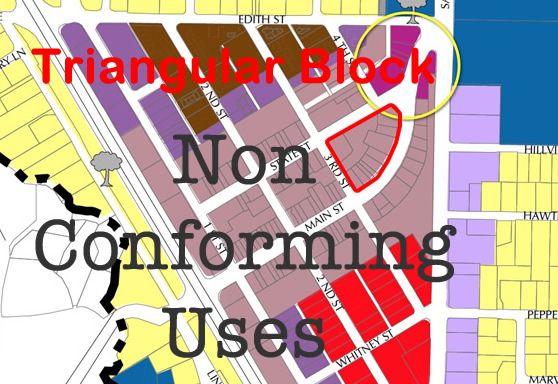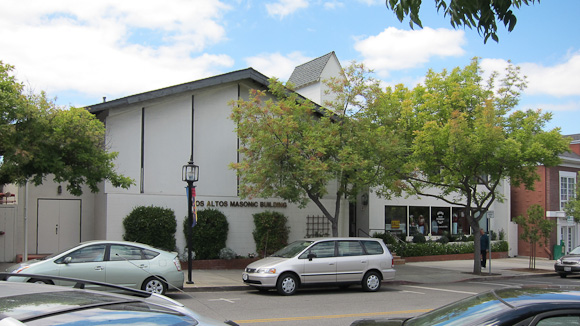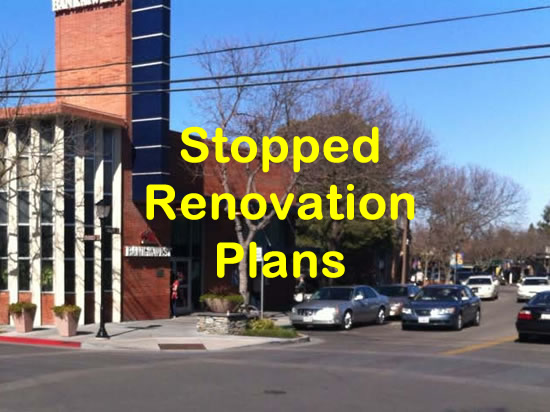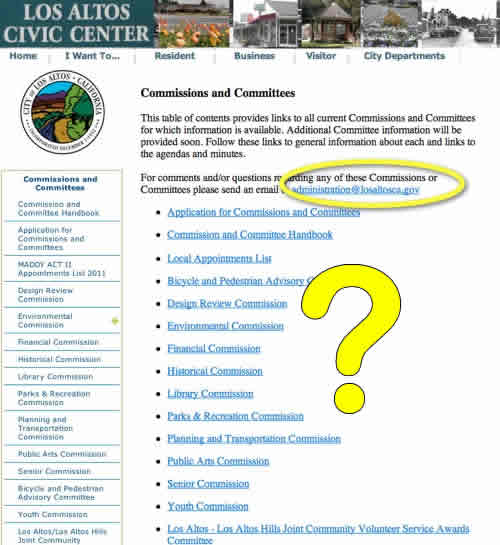Collaboration, not Amortization
Monday July 16 was the final meeting of the Los Altos City Council subcommittee studying “amortization” as a way to enhance retail vitality in downtown Los Altos. Amortization is zoning that would have put a time limit – usually 4 to 8 years – on common Main Street and State Street non-conforming uses like banks, law offices, travel agencies, costume rental shops, fraternal associations, and beauty salons. After the time limit, the properties could have only been leased for retail businesses, not services. Non-conforming uses would have gotten the boot.
The Ad Hoc Contiguous Retail Subcommittee – Jarrett Fishpaw, Deb Hope, Ron Packard, Scott Ritches, Gabrielle Tiemann — unamimously decided against using the “hammer” of amortization to effect retail change at this time. They conducted nitty-gritty research into lists of every parcel in the downtown Los Altos core, in depth interviews with affected owners, and heard extensive public comment.
All the businesses which have felt most “targeted” by the subcommittee — including the Costume Bank, the Masonic Temple, the law offices, the travel agent, Chase Bank, Bank of the West, Citibank – are breathing a sigh of relief. Their “difficulty with the City” is over with. They are not being “run out of town.”
the Costume Bank, the Masonic Temple, the law offices, the travel agent, Chase Bank, Bank of the West, Citibank – are breathing a sigh of relief
The Recommendations
The expected recommendations of the sub-committee to the full City Council include
1) Hire an urban planning infill consultant to test solutions collaboration among owners in the “Triangular Block” – Main, State and Third. The subcommittee identified this as the block with the highest percentage of nonconforming uses and as least attractive to shoppers.
2) Consider selling or leasing a portion of City-owned Parking Plaza 6 facing State Street ,so it could be developed as retail. Make sure the forthcoming Downtown Parking Study includes this factor.
3) In parallel with the test of collaboration among owners in the Triangular Block, the City should propose leasing the Bank of the West drive through for a pop-up store, open space, or outdoor vending.
4) Zoning should be amended to allow existing non-conforming banks (Chase, Citibank, Bank of the West) to legally move to smaller locations downtown.
5) City should help the Masonic Lodge plan and finance improvements to its front façade.
6) The Costume Bank rental use is interpreted to be conforming. However, the travel agency and the law office in the Triangular Block are not, but are part of the test of solutions collaboration mediated by the urban planning infill consultant.
7) There is a trend for beauty/nail salon locations that are closing down on State and Main to convert to new retail tenants, so no amortization is necessary for now. As before, salons can relocate to plaza and side street locations.
8) The subcommittee can be reorganized and restarted after completion of the test of solutions collaboration among owners in the Triangular Block.

Under consideration: City may sell part of Parking Plaza 6 for retail, rearrange businesses on Main, make parklettes
Fox in the Henhouse -Developer vs. Consultant
During the public discussion there was only one significant change to the language of the draft recommendations. There was concern about what to call the person hired by the City to manage the test of solutions collaboration among owners in the Triangular Block. Originally a “developer” was to be hired, but that word suggested an interested land owner would be put in charge. That was the opposite of the intent. The term was changed to urban planning infill “consultant.”
PARTIAL TRANSCRIPT
SELECTED QUOTES
Los Altos Politico has selected quotes from the meeting in rough chronological order that will give a reader a good sense of the meeting. The discussion did meander at times. Explanations are inserted in brackets to clarify the meaning.
Why the Recommendations Report is so Long
Council member Ron Packard began the meeting by explaining how the report he wrote should be clear, and balanced, reflecting all members of the committee. He decided against just bullet points, and instead wanted to write at some length to capture some key knowledge and reasoning.
Ron Packard: I tried to reflect the committee. But this [amortization study] has gone a direction I didn’t expect [a vote against]…It’s nice to have a legislative history.
It’s nice to have a legislative history
Gabrielle Tiemann, subcommittee member and Senior Commissioner: As we would say in the League of Women Voters, we have reached consensus….I think it is very easy for people to understand that we didn’t want to hit them over the head.
Communications with Costume Bank and Masonic Temple
A member of the public affiliated with the Costume Bank asked Ron Packard a question: “Who did you meet at the costume bank and when?”
He said he met with a key Costume Bank manager at Main Street Café several times over the years. [not at the Costume bank, and there were no other attendees] Packard: [The most recent time ] was just after the subcommittee was approved, but before it had been organized. So the discussion was about relocation, not amortization.
the discussion was about relocation, not amortization
Person with Costume Bank suggested that in the future, direct personal communication would be better. She said: “The Masons thought the City was going to try to shut them down.”
Ron Packard seemed puzzled and said: “Interesting that the Masons thought that.”
Communications with Banks
Mary Prochow, local commercial realtor and downtown property owner, suggested that direct personal communication be used later that day. Several people expressed a desire that those who had felt threatened should not learn about the subcommittee recommendations in the newspaper, or after a press release, but rather from a courtesy phone call from the City.
Mary Prochow: Half a dozen properties-businesses were targeted…It’s easy to pick up the phone. Say, ’This is our conclusion. It’s overwith’… Two banks stopped renovations because of the activity and inquiries of this subcommittee. Both Chase and Bank of the West stopped. [Call them so they will start the renovations!]
Two banks stopped renovations because of the activity and inquiries of this subcommittee. Both Chase and Bank of the West stopped
“Why engage a ‘Developer’ for the Collaboration?”
Penny Lave, former Mayor of Los Altos, opened up discussion of the unfortunate use of the word “developer” when the subcommittee really intended something else.
Penny Lave: What is the definition of a professional developer, and what do you expect them do?
Packard: None of us on this committee are real developers. Somebody who knows the ropes could be engaged by the City.
Jarret Fishpaw, City Council member: We mean something like Project for Public Spaces. Like Fred Kent. But not Fred Kent.
Scott Ritches, subcommittee member: Developer is not the right word. It is no one with a vested interest. It is not a property owner.
Developer is not the right word. It is no one with a vested interest. It is not a property owner
Mixed Public Voices: Revitalization consultant? Urban planning consultant? Infill consultant? Open space consultant? Retail development consultant?
More on Improving City Communications
Deb Hope, subcommittee member: Let’s have better communications, Keep journals of contacts. I talked with so and so on such and such a date. Then there is context going forward.
Brook Ray Smith, Pasarelle Investments: This committee was not on the web site. You don’t make it really easy for busy people to know what is going on.
You don’t make it really easy for busy people to know what is going on
Ron Packard: I find it very frustrating that City web site doesn’t have a calendar… Where am I supposed to be today?
Penny Lave: I asked the City why this meeting wasn’t being noticed. .. I’m only getting the agenda by email.
Jolie Houston: There is no Brown Act requirement to notice ad hoc subcommittee meetings.
Jarrett Fishpaw, City Council member: Perhaps we could work with our council norms about noticing ad hoc subcommittees… I’m on the other ad hoc subcommittee – the 60th Anniversary of the City subcommittee. It’s not noticed or on the web site…So I’m thinking to myself, is this the first Thursday? Is it 9am?
In response to Deb Hope requesting the printed paper notices be put around town for the non-computer literates, especially seniors, Gabrielle Tiemann had this response: “Seniors are very computer literate. Yes, there are still some 85-90 year-olds who are still afraid of the computer… [but many have laptops to die for, from this group I get phone calls]…I know you told me it’s on the City web site, so where do I find it?”
I know you told me it’s on the City web site, so where do I find it?
Brainstorming Ways the ‘Triangular Block” could be Organized
The conversation turned to how the Triangular Block could conceivably be organized, other that on a totally individualistic basis.
Brooke Ray Smith: One way is even smaller, less scary than a redevelopment assessment district… a business improvement district can be property based or business based. Property owners or business owners could chip in help pay for improvements in their district. There is no redevelopment being talked about in these cases
Jolie Houston, City Attorney: A petition to form a district, needs 50% of the signatures. We need to go through prop 218… Property owners have to say, ‘We want to do this’… The assessement need to be assessed… Then there is a protest period.
A petition to form a district, needs 50% of the signatures… Property owners have to say, ‘We want to do this’
…
Mary Prochow: To counter that, the San Antonio Project at El Camino had just 4 owners…that had to agree to start. [This Triangular Block has about a dozen.]
Fishpaw: The assessment district would be in charge of spending that [ any pool of money].
Prochow: I want to spend it [ my share maintenance money] on my building, as directed by me….
Someone: “ You, Mary Prochow, could be in charge of the assessment district.” [Room Laughter.]
LALAHPOLITICO COMMENT: Ms. Prochow did not warm to the opportunity to, the power to, spend other people’s money. Thank you but, she’ll spend her money. And you should please spend yours to keep your place up. This approach resonates with Lalahpolitico. Sigh, but why is it that the people you wish were in charge, don’t want to be in charge?
Collaborating – for Construction, Perhaps Major but Mainly Minor
Packard switched the conversation from talk of maintenance type spending, asking for focus on construction and uses, as opposed to regular gardening maintenance.
Brooke Ray Smith: Here is another brainstorming idea: You need to have incentives for the owners on this block [ Triangular Block] to want to do something different. That’s where the City’s zoning tools are important. …To allow the city to retain some of the bargaining tools…there could incentives that could be granted in exchange for participating in a district…like if they were allowed the block to do a little bit more development than the code would otherwise allow … or some way the property owners could get more bang for their buck on their land than is typically allowed by the zoning code. I’m just throwing that out there, to have the negotiation tools with the City can be helpful in effecting a larger vision . Otherwise, a single property owner has no incentive to want to think bigger than their own lot line.
…some way the property owners could get more bang for their buck on their land than is typically allowed by the zoning code…otherwise, a single property owner has no incentive to want to think bigger than their own lot line
Penny Lave: Is a small Business Investment District legal?. We tried it for the whole downtown trianglee back whenever. There was a lot of hoopla. But it didn’t fly.”
Jolie Houston, City Attorney: Yes , You can do a small one. There are 1989 and 1984 acts…It takes 50% of signatures for the petition to form it. Then a ballot protest.
Brooke Ray-Smith: Former Los Altos economic development manager, Abby Visser, wrote a 2003 document saying the City likes to see 70% participation in a BID…A zoning overlay is another tool. A tool for collaboration or improvement.
Storefront Cleanliness Standards
Deb Hope : Does the City have any downtown cleanliness standards?
Packard: This had been a thorn in our side for along time… No,not really.
Fishpaw: But yes we do have a stickiness standard. ‘It it too sticky today? Did my shoe stick to the sidewalk and come off?
Did my shoe stick to the sidewalk and come off?
Houston: We are getting powerwashing 6 times a year now.
Prochow: Once a week is barely enough. Before stains become permanent.
Packard: The managers [ at Jamba Juice and Starbucks ] change every other month… So just when you get them to understand… The landlords don’t want anything to do with it.
When Money is too Tight for Renovations – City Could Help
Person from Costume Bank: “You act as though it is very easy for property owners to make renovations. What is the payback going to be?… Not through a $3.95 Hallmark card? How can you get one million or 2 million for a renovation back? …The banks probably pays a good rent…. But lots of these retailers can’t pay that.
Ron Packard: I assume that for some property owners – the Masonic Temple or Costume the Costume bank — the City will have to assist in that…There are grants…We acknowledge that money is tight.”
Jarrett Fishpaw: The recommendations in the document show we are being sensitive to the property owners…We know they can’t just pull out the checkbook to pay for a renovation.
We know they can’t just pull out the checkbook to pay for a renovation
Packard: This [subcommittee] has been a worthwhile effort… I’ve wanted to look at amortization for several years, and now we have… If the City does engage a consultant, a subsequent committee may reconvene… You have to get your hands [into the details] to see if it makes sense or does not make sense. When you really get into it, you see the benefits of having these two organizations [Costume Bank, Masonic Temple] staying on the block.
Note: You can find more of our posts with the public comments made at these retail subcommittee meetings by searching on this site for “los altos retail.’


















[…] hoc Continuous Retail Committee final report had slight cosmetics changes. More here and also […]
[…] LALAHPOLITICO: It is interesting that none of the suggestions of the Report were acted upon. See Story here. none of the suggestions of the ad hoc Contiguous Retail Committee Report were acted upon at this […]